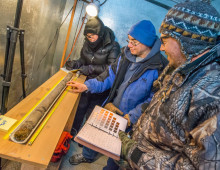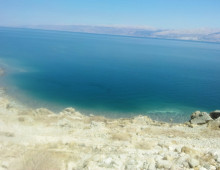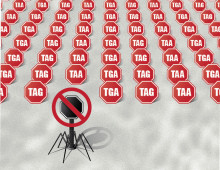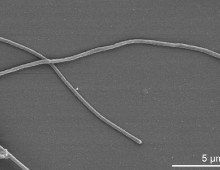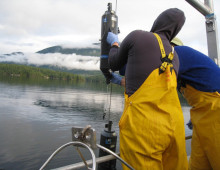A review of studies to better understand effects of climate change on microbial activities. The Science: Researchers are harnessing strategies including metagenomics to learn more about the microbial communities in permafrost and their current and potential responses to climate change. The Impact: Researchers estimate that permafrost covers a quarter of the plant’s land area, and…
Seeding a salty agricultural future
Fungal genome offers insights into growing crops in salty environments. The Science: Researchers sequenced and analyzed the genome of an extremophilic fungus that has adapted to thrive in the Dead Sea. The Impact: The genome provides information on how the fungus can tolerate extremely salty conditions. As climate change continues to affect agricultural lands and…
A Glimpse into Nature’s Looking Glass—To Find the Genetic Code is Reassigned
In the Lewis Carroll classic, Through the Looking Glass, Humpty Dumpty states, “When I use a word, it means just what I choose it to mean—neither more nor less.” In turn, Alice (of Wonderland fame) says, “The question is, whether you can make words mean so many different things.” All organisms on Earth use a genetic code, which is…
Defining function from “genomic dark matter”
Functional annotation reveals novel biomass-degrading enzymes from microbial genomes. The Science: Functional annotation allowed researchers to identify biomass-degrading enzymes in the 35 percent of genes in a genome that are considered “genomic dark matter.” The Impact: Identifying 17 putative biomass-degrading cellulases from the content of more than 5,500 microbial genomes is of use to bioenergy…
Single species reveals a myriad of genomic variations
Single cell genomics reveals diversity of cyanobacteria subpopulations. The Science: Single cell genomics allowed researchers to examine the subpopulations of the marine microbe Prochlorococcus, affording a glimpse at “a new dimension of microdiversity.” The Impact: The cyanobacterial subpopulations were found to be distinct, comprised of “genomic backbones” made of highly conserved core gene alleles and…
Salt Needed: Tolerance Lessons from a Dead Sea Fungus
Despite its name, the Dead Sea does support life, and not just in the sense of helping visitors float in its waters. Algae, bacteria, and fungi make up the limited number of species that can tolerate the extremely salty environment at the lowest point on Earth. Some organisms thrive in salty environments by lying dormant…
A recipe for amplifying genomes cell by cell
Detailed protocol outlines steps for extracting ample DNA from uncultured microbes. The Science: Characterizing uncultured microbes starts with isolating and sequencing enough DNA from an environmental sample that may be as small as a single cell. The Impact: The protocol has been successfully employed to amplify the genomes of 201 single cells from uncultured microbes…
#JGInPoetry – Genomics in Verse
Our call for verses to help us communicate our science yielded several poems, a couple of which even met the writing challenges we set. We’ve shared these on social media and we hope the muse continues to inspire as we look forward to receiving more poems about genomics, energy and environment. “Ode to a Gutless…
Steven Hallam, University of British Columbia
CIFAR Scholar and Associate Professor, University of British Columbia Department of Microbiology & Immunology, Life Sciences Institute I have collaborated with the JGI since 2002 before the CSP program came online. These collaborations have spanned my postdoctoral years with Ed DeLong [now at the University of Hawai’i, Mānoa] and my time as an independent investigator at the University…
Going deep to improve maize transcriptome
Researchers employ RNA-Seq techniques to improve annotations for analysis. The Science: A team of researchers from the U.S. Department of Energy Joint Genome Institute (DOE JGI), the University of California, Berkeley, and the Great Lakes Bioenergy Research Center generated an ultra-deep, high quality transcriptome–the fraction of the genome that provides information about gene activity–of maize….
